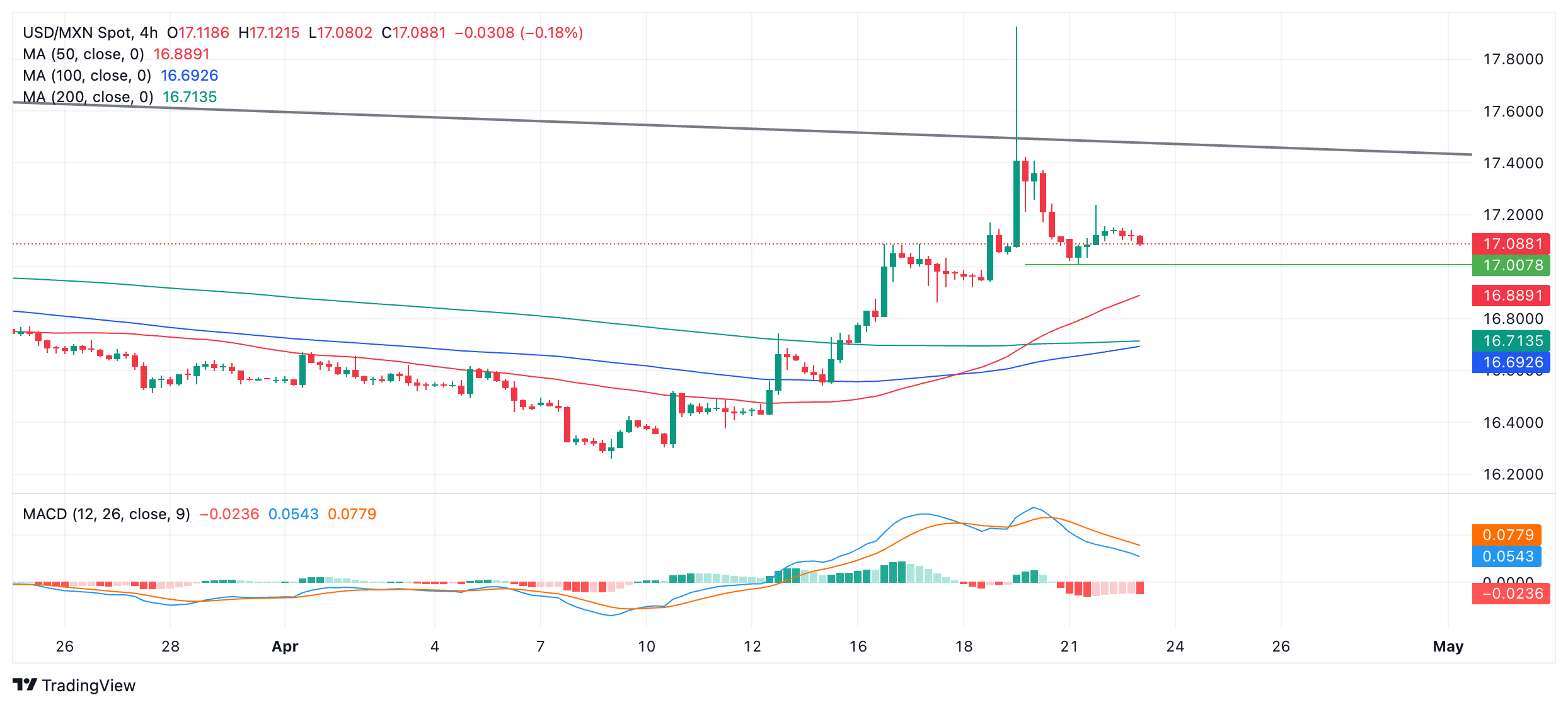Mexican Peso trades higher in major pairs after global Manufacturing PMIs enter contraction
- The Mexican Peso trades higher in most pairs as global Purchasing Manager Indices (PMI) for April are released.
- Manufacturing PMIs in both the Eurozone and US decline, weighing on the Euro and US Dollar.
- Mexican Economic Activity data failed to inject much volatility into the Peso on Monday.
- The short-term uptrend looks vulnerable to breakdown.
The Mexican Peso (MXN) is trading higher in its most heavily-traded pairs on Tuesday after the release of dissapointing US and Eurozone PMI data weighed on the US Dollar (USD) and the Euro (EUR).
In Europe, weaker preliminary HCOB Manufacturing PMI data for April showed the sector contracting even more into negative territory, whilst in the US, S&P Global Manufacturing PMI fell unexpectedly to 49.9, which is below the 50 that distinguishes growth from contraction. The result was considerably lower than the 51.9 of March and the 52.0 forecast.
Overall, the Mexican peso continues recovering in its major pairs, especially versus USD after plummeting temporarily at the end of last week, but then reverting to mean after fears of an escalation in the conflict in the Middle East abated.
Mexican Peso shrugs off macro data
The Mexican Peso did not gain much traction on Monday despite the release of better-than-expected macroeconomic data for February. Economic Activity rose 1.4% MoM and 4.4% YoY in the second month of the year compared to January’s 0.9% and 1.9% increases, respectively, according to data from the Instituto Nacional de Estadistica, Geografia e Informatica (INEGI).
Other news relevant to MXN included comments from Banxico Governor Victoria Rodriguez Ceja, who said that services inflation is not showing a clear downward trend.
Rodriguez Ceja added that the Mexican Peso’s strength has, at times, helped contain inflation by lowering the cost of imported goods.
Her comments reinforce the view that the central bank will be data dependent in its approach to monetary policy going forward.
In March, Banxico cut interest rates by 0.25% for the first time in three years after inflation showed progress lower. The minutes of the meeting, however, showed a lack of conviction about whether inflation had fallen in a sustainable fashion. This suggested another cut at their next meeting in May is not guaranteed.
Mexican mid-month inflation data for April, out on Wednesday, could adjust expectations for the Banxico’s policy approach going forward.
Mid-month inflation in March stood at 4.48% for headline and 4.69% for core YoY, and 0.27% and 0.33%, respectively, on a monthly basis.
A higher-than-previous result is likely to further lower the probability of the central bank following up the March rate cut with another cut in the near term, and vice versa for a lower-than-previous result.
Interest rates are a major driver of Forex markets. Higher interest rates appreciate a currency by attracting more inflows of foreign capital and the opposite for lower interest rates.
Technical Analysis: USD/MXN short-term uptrend vulnerable
USD/MXN continues to trade below a major trendline for the long-term downtrend, despite briefly breaking above the line last week during the highly volatile reaction to the Israel-Iran conflict.
The brief piercing of the trendline and spike higher reversed the short-term and intermediate-term downtrends but not the longer-term trend, which remains bearish.
USD/MXN 4-hour Chart
A closer look at the 4-hour chart shows that the new short-term uptrend is vulnerable. A break below Monday’s 17.01 swing low would bring the short-term uptrend into doubt.
The Moving Average Convergence/Divergence (MACD) has crossed its signal line, giving a sell signal and is falling in line with price, overall painting a bearish picture.
If a pullback persists, support from the 100-day SMA at 16.96 followed by the 50-day SMA at 16.82 is likely to provide a foothold for the backsliding price.
A decisive break above the trendline at roughly 17.45 would provide bullish reconfirmation and activate an upside target at roughly 18.15.
A decisive break would be one characterized by a longer-than-average green daily candlestick that pierces above the trendline and closes near its high, or three green candlesticks in a row that pierce above the level.
Economic Indicator
S&P Global Manufacturing PMI
The S&P Global Manufacturing Purchasing Managers Index (PMI), released on a monthly basis, is a leading indicator gauging business activity in the US manufacturing sector. The data is derived from surveys of senior executives at private-sector companies from the manufacturing sector. Survey responses reflect the change, if any, in the current month compared to the previous month and can anticipate changing trends in official data series such as Gross Domestic Product (GDP), industrial production, employment and inflation. A reading above 50 indicates that the manufacturing economy is generally expanding, a bullish sign for the US Dollar (USD). Meanwhile, a reading below 50 signals that activity in the manufacturing sector is generally declining, which is seen as bearish for USD.
Last release: Tue Apr 23, 2024 13:45 (Prel)
Frequency: Monthly
Actual: 49.9
Consensus: 52
Previous: 51.9
Source: S&P Global


